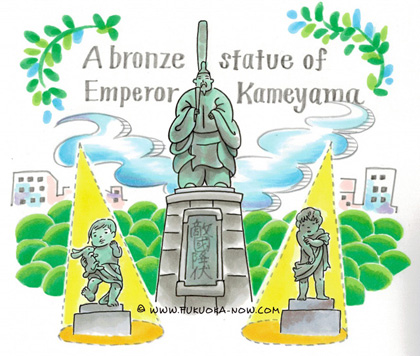Hakata Culture vol.121
Choun Yamazaki: A Famous Sculptor from Hakata

In the middle of Higashi Park stands a bronze statue of Emperor Kameyama, who ruled in the Kamakura period at the end of the 13th century. When the Mongols invaded, he visited shrines throughout Japan to pray for their surrender. During the first Mongol invasion, Hakozakigu Shrine was burned to the ground. When it was rebuilt, Emperor Kameyama presented the shrine with a piece of calligraphy reading tekikoku kofuku, or “surrender of the enemy nation,”and these same characters now hang above the shrine’s tower gate.
The sculptor of the Emperor Kameyama statue was Choun Yamazaki (1867~1954). He was born in Fukuoka—his real name was Harukichi—in what it now known as Reisenmachi in Hakata Ward. After learning traditional wood carving techniques from a Buddhist sculptor, he moved to Tokyo to become an apprentice to Choun Takamura, one of Japan’s leading sculptors. Yamazaki won awards at many exhibitions and was involved in the founding of the Japan Sculptors Association. He later became one of the major forces in modern sculpture in Japan. He spent a great deal of energy training the next generation of sculptors, and one of his many students was another Fukuokan, Chodo Tominaga (1897~1987).
Although many of Yamazaki’s works are on display in museums, some of them, like the statue of Emperor Kameyama in Higashi Park, can be found in public places. What’s more, at Hakozaki Shrine, you can see the impressive six meter tall wooden model used to make the bronze statue. The wooden models for bronze statues are usually discarded, so the fact that this one remains is quite rare.
You can also find another Yamazaki work called “Katsura no Kage” on Meiji-dori Ave. “Katsura no Kage”, a reference to an ancient Chinese legend, means moonlight, and the statue shows a small child holding a rabbit and counting down on his fingers awaiting spring. Yamazaki also sculpted another statue of a child that is located next to the Jonan Ward Health Center. Called “Shuzo” (literally, “smallpox vaccination”), it shows a child peering at his arm after having just received a smallpox vaccination.
博多出身の著名な彫刻家・山崎朝雲
緑豊かな東公園の中心に立つ亀山上皇の銅像。亀山上皇は鎌倉時代の13世紀に蒙古が襲来した際、「我が身をもって国難に代わらん」と各地の神社に敵国降伏を祈願しました。蒙古軍によって炎上した筥崎宮の社殿を再興するときにも「敵国降伏」の宸筆を納め、現在その文字は筥崎宮の楼門に掲げられています。この亀山上皇像を制作したのが博多出身の彫刻家・山崎朝雲(1867~1954)です。
山崎朝雲は筑前国博多櫛田前町(現在の博多区冷泉町)に生まれ、本名を春吉といいます。仏師のもとで伝統的な木彫技法を学び、その後上京して日本を代表する彫刻家・高村光雲に師事しました。さまざまな展覧会で受賞を重ね、日本彫刻会の結成にも参加。のちに近代彫刻界の重鎮となります。後進の育成にも力を入れ、その中には冨永朝堂など福岡出身の門下生も多くいました。
朝雲の作品は美術館などに収蔵されていますが、もっと気軽に街中でも見ることができます。そのひとつが代表作である東公園の亀山上皇像。さらに、この銅像の原型となる木彫像も筥崎宮で見ることができます。境内の「亀山上皇尊像奉安殿」には高さ約6メートルの巨大な木彫像が納められ、その迫力に圧倒されます。銅像の原型は破棄されることが多く、こうして残っているのはめずらしいのだとか。
また、明治通り沿いにあるのが「桂の影」と名づけられたウサギを手に持った童子の作品。「桂の影」とは昔の言葉で「月の光」を意味し、春の訪れを指折り数えている姿だそう。さらに、城南保健所横には「種痘」と彫られた台座に立つ幼児像が。天然痘の予防接種である種痘を終えたばかりの幼児が、種痘跡をのぞき込んで安堵している様子だそうです。

